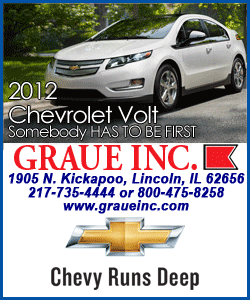 William
"Duff" Armstrong had been
charged along with his friend
James Norris in the murder of
James Preston Metzker in an
outside altercation around 11
o'clock on the night of Aug. 29,
1857 -- all three being reported
to have been under the influence
of liquor following a religious
meeting on the outskirts of a
camp in Mason County. William
"Duff" Armstrong had been
charged along with his friend
James Norris in the murder of
James Preston Metzker in an
outside altercation around 11
o'clock on the night of Aug. 29,
1857 -- all three being reported
to have been under the influence
of liquor following a religious
meeting on the outskirts of a
camp in Mason County.
In an earlier trial, Norris
had been accused and found
guilty of murdering Metzker with
a lethal blow to the back of the
head. Armstrong was now on
trial, being accused of hitting
Metzker on his forehead with a
"slung-shot" -- a weight tied to
a leather thong.
Morris, the guest speaker,
related that the last wish of
Duff's dying father was for
Duff's mother to contact his old
friend Abraham Lincoln to take
the case -- which had changed
venues to the Beardstown
Courthouse in Cass County due to
the previous conviction of
Norris in the volatile community
of Mason County.

The speaker acknowledged that
he has done much research on
this particular trial over the
years, as evidenced by his
quoting several sources
throughout his talk. He reported
that Lincoln used not just one,
but four clever but sound
tactics to aid his case. Morris
said that certainly, as a
package of tactics, this was not
typical of trials of the
mid-1800s. Actually, as he
further explained, three of
these four tactics were not
typical of any mid-1800s trials
in this area. Nevertheless, all
excellent trial lawyers, then as
now, usually produce more than
one piece of evidence or
testimony to aid their case.
Thus, said Morris, this trial
"illustrates once again the
superb abilities of Abraham
Lincoln as a trial lawyer."
(Note: Lincoln worked on very
few murder trials during his
lawyer days -- about 20 years.)
For his first strategy,
Lincoln produced several copies
of an almanac, which he passed
out to the judge and jury,
illustrating that the moon was
not full, not three-quarters,
not half, but only one-quarter
on that night, and that it was
very low in the sky at that
point, setting three minutes
after midnight. Obviously, this
refuted the testimony of the
star witness, Charles Allen --
who had testified just a few
minutes before Lincoln's sudden
introduction of the almanac --
that he saw Armstrong from about
150 feet away and clearly saw
him swinging the slung-shot, by
the "light of the moon."
Lincoln also noted to the
jury that at this particular
scene, there was a clump of
trees between the altercation
and the setting of the moon in
the western sky. As suggested by
a "roar of laughter" in the
courtroom, this may have been
enough to get the acquittal of
his client.
However, Lincoln proceeded to
introduce more evidence for his
client's exoneration.
He requested Dr. Charles
Parker to the stand. Parker
testified that the blow to the
back of the head was not only
severe and lethal enough to
cause the fatality, but also
probably caused the frontal
contusion. This testimony
appeared to explain, then, that
the previously convicted Norris
had indeed been the murderer.
More important, the doctor was
stating that there was neither
hard evidence nor need of a
frontal blow to the forehead as
purportedly done by Armstrong.

For a third stratagem,
Lincoln called upon the owner of
the slung-shot, who testified
that it was indeed his device
and it was not used by him nor
anyone else that night. (This
may have been a bit tricky -- a
chance that Lincoln took, since
a redirect by the prosecution
may have revealed that this
slung-shot owner did indeed
witness the killing by both
Norris and Armstrong, using
their bare hands or other
instruments. There was no
redirect.)
[to
top of second column] |

Lastly, according to Morris
-- perhaps most significantly
and certainly out of character
-- Lincoln became very emotional
as he pleaded to the jury that
Armstrong's loving family had
taken him into their home on
several occasions to feed and
comfort him back in the days of
struggles to make ends meet.
Morris then reviewed what
many of us already knew: Duff's
father, Jack, had once
challenged Lincoln to a
wrestling match in New Salem,
and it was widely known that
Jack was the strongest man
around. When Lincoln stood up to
him and did not waver nor suffer
defeat -- it was reportedly a
draw -- then the entire
community and countryside
accepted young Lincoln ever
after. It was common knowledge
then as it is today that Abraham
Lincoln and Jack Armstrong
became lifelong friends from
that time henceforth.
The speaker then posed a
question: "Did Abraham Lincoln
choose friendship over justice?
Did his lifelong friendship with
Jack Armstrong give Lincoln
enough motivation to 'go to bat'
for his son, guilty or not
guilty?"
Morris answered his
rhetorical question with his
personal view -- now widely held
-- that in this drunken brawl,
both tipsy men beat up on the
belligerent, combative and
drunken Metzker, resulting in
his death. Nevertheless,
everyone in that Beardstown
courtroom, including the jury
and the prosecution lawyer,
digesting all of Lincoln's
support data and testimony, came
to the conclusion that it was
only Norris' blow to the back of
Metzker's skull that caused the
death. Finally, everyone
including Lincoln now thought
that one convicted assailant was
enough in this rowdy brawl.
Indeed, during the course of
this trial, lawyer Lincoln may
have convinced himself of his
friend son's acquittal.
A few years later, President
Lincoln had a hand in commuting
Norris' sentence.

As a sidelight, the speaker
pointed out that Lincoln wore a
white suit that day of the trial
-- something that he never
reportedly did before nor ever
again. Further, Morris said that
on the same day, following the
trial theatrics, Lincoln was
asked to walk over to the nearby
studio of a young 22-year-old
Abraham Byers for a photograph (ambrotype
-- negative on glass). Morris
lamented that while there is a
copy of this photograph in the
Beardstown museum, the original
ambrotype glass negative is on
display in a museum in Lincoln,
Neb.
In parting, Morris informed
the group that the Beardstown
Courthouse is the only existing
courthouse in which Abraham
Lincoln worked as a lawyer and
which still continues today as
an active city courtroom (Cass
County seat was long ago moved
from Beardstown to nearby
Virginia, Ill.). The Beardstown
courtroom remains on the second
floor of the old courthouse,
with the museum on the first
floor.
[By PHIL BERTONI, member and
webmaster for the
Logan County Genealogical &
Historical Society] |